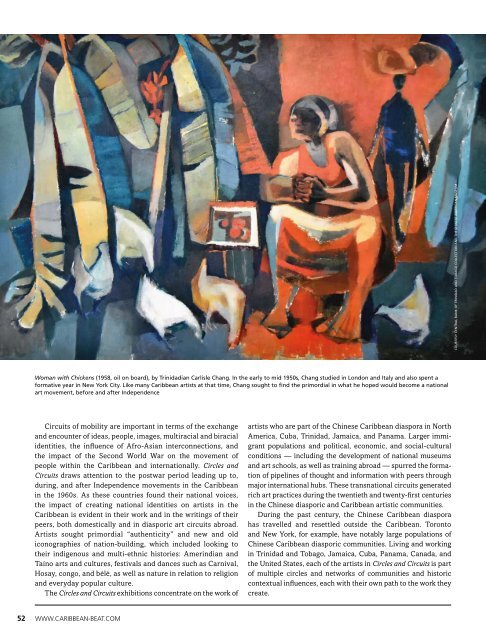Caribbean Beat — November/December 2017 (#148)
A calendar of events; music, film, and book reviews; travel features; people profiles, and much more.
A calendar of events; music, film, and book reviews; travel features; people profiles, and much more.
Create successful ePaper yourself
Turn your PDF publications into a flip-book with our unique Google optimized e-Paper software.
Courtesy Central Bank of Trinidad and Tobago Collection and the Chinese American Museum<br />
Woman with Chickens (1958, oil on board), by Trinidadian Carlisle Chang. In the early to mid 1950s, Chang studied in London and Italy and also spent a<br />
formative year in New York City. Like many <strong>Caribbean</strong> artists at that time, Chang sought to find the primordial in what he hoped would become a national<br />
art movement, before and after Independence<br />
Circuits of mobility are important in terms of the exchange<br />
and encounter ofideas, people, images, multiracial and biracial<br />
identities, the influence of Afro-Asian interconnections, and<br />
the impact of the Second World War on the movement of<br />
people within the <strong>Caribbean</strong> and internationally. Circles and<br />
Circuits draws attention to the postwar period leading up to,<br />
during, and after Independence movements in the <strong>Caribbean</strong><br />
in the 1960s. As these countries found their national voices,<br />
the impact of creating national identities on artists in the<br />
<strong>Caribbean</strong> is evident in their work and in the writings of their<br />
peers, both domestically and in diasporic art circuits abroad.<br />
Artists sought primordial “authenticity” and new and old<br />
iconographies of nation-building, which included looking to<br />
their indigenous and multi-ethnic histories: Amerindian and<br />
Taíno arts and cultures, festivals and dances such as Carnival,<br />
Hosay, congo, and bélé, as well as nature in relation to religion<br />
and everyday popular culture.<br />
The Circles and Circuits exhibitions concentrate on the work of<br />
artists who are part of the Chinese <strong>Caribbean</strong> diaspora in North<br />
America, Cuba, Trinidad, Jamaica, and Panama. Larger immigrant<br />
populations and political, economic, and social-cultural<br />
conditions <strong>—</strong> including the development of national museums<br />
and art schools, as well as training abroad <strong>—</strong> spurred the formation<br />
of pipelines of thought and information with peers through<br />
major international hubs. These transnational circuits generated<br />
rich art practices during the twentieth and twenty-first centuries<br />
in the Chinese diasporic and <strong>Caribbean</strong> artistic communities.<br />
During the past century, the Chinese <strong>Caribbean</strong> diaspora<br />
has travelled and resettled outside the <strong>Caribbean</strong>. Toronto<br />
and New York, for example, have notably large populations of<br />
Chinese <strong>Caribbean</strong> diasporic communities. Living and working<br />
in Trinidad and Tobago, Jamaica, Cuba, Panama, Canada, and<br />
the United States, each of the artists in Circles and Circuits is part<br />
of multiple circles and networks of communities and historic<br />
contextual influences, each with their own path to the work they<br />
create.<br />
52 WWW.CARIBBEAN-BEAT.COM


















